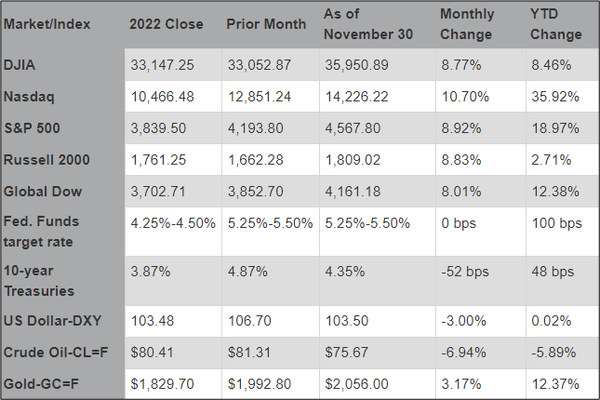Market Month: November 2023
The Markets (as of market close November 30, 2023)
Stocks rose notably in November following three straight months of declines. The Nasdaq led the benchmark indexes listed here, followed by the S&P 500, the Russell 2000, the Dow, and the Global Dow. Overall, indexes enjoyed their best month since late 2022 and the best November in three years. Signs of waning inflationary pressure powered investor optimism that the Federal Reserve may be done raising interest rates.
The most recent inflation data showed price growth slowed in October. Both the Consumer Price Index and the personal consumption expenditures price index showed annual rates of inflation receded (see below).
The Federal Reserve met in November and maintained the federal funds target rate range at its current 5.25%-5.50%. While noting that inflation appears to be slowing, the Fed left future interest rate hikes on the table should inflation turn less favorable. The Fed next meets in mid-December. It will be interesting to see whether some of the members hint at a possible interest rate reduction heading into 2024. However, while inflation has begun to trend lower, it remains above the Fed's target of 2.0% and the economy has shown resiliency, all of which supports the Fed's apparent cautious approach.
The economy has proven resilient despite an autoworkers strike, the ongoing war in Ukraine, and the Israel-Hamas conflict. Third-quarter gross domestic product expanded at an annualized rate of 5.2%, according to the second estimate. Consumer spending, which makes up about 70.0% of the economy, rose, with increased spending in durable goods, nondurable goods, and services. Gross domestic income rose 1.5% in the third quarter. Rising income should help expand the economy moving into the fourth quarter.
Job growth slowed in October, with only 150,000 new jobs added. Wages continued to rise, increasing 4.1% over the last 12 months. Along with declining job growth, unemployment claims increased from a year ago (see below), reaching their highest level since late 2021.
The third quarter saw U.S. companies enjoy their biggest year-over-year gain in earnings since the second quarter of 2022. With almost all of the S&P 500 companies reporting, overall earnings are estimated to be more than 6.0% above earnings totals from a year ago. More than 80.0% of quarterly reports exceeded analysts' earnings expectations. In addition, third-quarter corporate profits in the U.S. surpassed the previous quarter by 4.1%, according to Trading Economics.
Sales of both new and existing homes retreated in October, primarily due to lack of inventory, high prices, and advancing mortgage rates. Sales of existing homes are down nearly 14.5% over the past 12 months, although sales of new single-family homes have increased nearly 18.0%.
Industrial production contracted in October following two months of gains. (see below). Conversely, manufacturing expanded in October, according to the latest survey from the S&P Global US Manufacturing Purchasing Managers' Index™, driven by an increase in new orders. The services sector also saw business accelerate in October.
Ten of the 11 market sectors ended November higher, with the exception of energy, which fell about 1.7%. Last month saw real estate, information technology, financials, communication services, and consumer discretionary climb by more than 11.0%.
Bond prices advanced in November, with the 10-year Treasury bond enjoying its best month since 2011. Investors are hedging their bets that the Federal Reserve is through hiking interest rates. Ten-year Treasury yields dropped notably, while the 2-year Treasury yield fell nearly 27.0 basis points to about 4.70% in November. The dollar inched higher against a basket of world currencies. Gold prices hit record highs following a slip in bond yields and a weakening of the U.S. dollar. Crude oil prices declined in November despite the turmoil in the Middle East and additional output cuts collectively agreed to by OPEC+. The retail price of regular gasoline was $3.238 per gallon on November 27, $0.295 under the price a month earlier and $0.296 lower than a year ago.
Stock Market Indexes

Chart reflects price changes, not total return. Because it does not include dividends or splits, it should not be used to benchmark the performance of specific investments.
Latest Economic Reports
- Employment: Employment rose by 150,000 in October from September following downwardly revised totals for August (227,000 to 165,000) and September (336,000 to 297,000). With these revisions, employment in August and September combined was 101,000 lower than previously reported. Over the last 12 months ended in October, the average monthly job gain was 258,000. In October, job gains occurred in health care, government, and social assistance. Employment in manufacturing declined due to worker strike activity. The unemployment rate ticked up 0.1 percentage point to 3.9% in October, while the number of unemployed persons rose by 146,000 to 6.5 million. The employment-population ratio dipped 0.2 percentage point to 60.2%, and the labor force participation rate decreased 0.1 percentage point to 62.7%. In October, average hourly earnings increased by $0.07, or 0.2%, to $34.00. Over the 12 months ended in October, average hourly earnings rose by 4.1%. In October, the average workweek edged down 0.1 hour to 34.3 hours.
- There were 218,000 initial claims for unemployment insurance for the week ended November 25, 2023. The total number of workers receiving unemployment insurance was 1,927,000. By comparison, over the same period last year, there were 213,000 initial claims for unemployment insurance, and the total number of claims paid was 1,554,000.
- FOMC/interest rates: The Federal Open Market Committee left the federal funds target rate unchanged following its meeting in November. The statement following the meeting indicated that, "The Committee would be prepared to adjust the stance of monetary policy as appropriate if risks emerge that could impede the attainment of the Committee's goals. The Committee's assessments will take into account a wide range of information, including readings on labor market conditions, inflation pressures and inflation expectations, and financial and international developments."
- GDP/budget: The economy accelerated at a notable pace in the third quarter, as gross domestic product increased 5.2%, according to the second estimate. GDP increased 2.1% in the second quarter. The increase in third-quarter GDP compared to the previous quarter primarily reflected a rise in consumer spending and private inventory investment, and an upturn in exports that were partly offset by a deceleration in nonresidential fixed investment. Imports, which are a negative in the calculation of GDP, were up. Nonresidential fixed investment rose 1.3% in the third quarter compared to a 7.4% increase in the second quarter. Residential fixed investment rose 6.2% in the third quarter after declining 2.2% in the prior quarter. Third-quarter GDP saw exports increase 6.0% (-9.3% in the second quarter). Imports rose 5.2% in the third quarter after dropping 7.6% in the second quarter. Consumer spending, as measured by personal consumption expenditures, rose 3.6% in the third quarter, compared to a 0.8% increase in the second quarter. The increase in personal consumption expenditures reflected increases in goods (4.7%) and services (3.0%). Consumer prices increased 2.8% in the third quarter compared to a 2.5% advance in the second quarter. Excluding food and energy, consumer prices advanced 2.3% in the third quarter (3.7% in the second quarter).
- The federal budget had a deficit of $67.0 billion in October, the first month of fiscal year 2024. Government receipts were $403.4 billion in October, while expenditures totaled $470.0 billion. Compared to October 2022, the monthly deficit was $87.9 billion, receipts were $318.5 billion, and expenditures were $406.4 billion.
- Inflation/consumer spending: According to the latest Personal Income and Outlays report, inflation continued to wane. Consumer prices, as measured by the personal consumption expenditures price index, rose less than 0.1% in October after climbing 0.4% in both August and September. Consumer prices, excluding food and energy, (core prices) increased 0.2% in October, down from 0.3% in September. Over the 12 months ended in October, consumer prices increased 3.0%, (3.4% for the 12 months ended in September). Core prices rose 3.5% for the year ended in October, down from 3.7% for the 12 months ended in September. Over the last 12 months, prices for goods increased 0.2% and prices for services increased 0.4%. Food prices increased 2.4%, and energy prices decreased 4.8%. Consumer spending increased 0.2% in October (0.7% in September). Personal income advanced 0.2% in October, down from 0.4% in September. Disposable personal income rose 0.3% in October after climbing 0.4% in September.
- The Consumer Price Index was unchanged in October compared to a 0.4% advance in September. Over the 12 months ended in October, the CPI advanced 3.2%, down from 3.7% for the 12 months ended in September. Core prices, excluding food and energy, rose 0.2% in October and 4.1% over the last 12 months. Prices for shelter were the largest contributors to the monthly all items increase, offsetting a notable decrease in energy prices. Gasoline prices fell 5.0% in October, while prices for food rose 0.3%. For the 12 months ended in October, food prices rose 3.3%; shelter prices increased 6.7%; energy prices dipped 4.5%; and gasoline prices declined 5.3%.
- Prices that producers received for goods and services decreased 0.5% in October after rising 0.4% in September. The October decline is the largest since April 2020. Producer prices increased 1.3% for the 12 months ended in October. Prices for goods fell 1.4% in October, marking the first monthly decrease since May 2023. Over 80.0% of the broad-based October decline in prices for goods was attributable to a 15.3% drop in prices for gasoline. Prices for foods decreased 0.2%. Prices for services were unchanged in October from the previous month, following six consecutive monthly increases. Prices for services rose 1.3% from October 2022.
- Housing: Sales of existing homes decreased 4.1% in October, marking the fifth consecutive month of declines. Since October 2022, existing-home sales dropped 14.6%. According to the report from the National Association of Realtors®, limited inventory and housing affordability continued to hamper home sales. In October, total existing-home inventory sat at a 3.6-month supply at the current sales pace, up from 3.4 months in September. The median existing-home price was $391,800 in October, down from the September price of $392,800 but well above the October 2022 price of $378,800. Sales of existing single-family homes dropped 14.2% in October and 14.6% from a year ago. The median existing single-family home price was $396,100 in October, down from the September price of $397,400 but above the October 2022 price of $384,600.
- New single-family home sales fell 5.6% in October, after advancing 12.3% in September. Overall, single-family home sales were up 17.7% from a year earlier. The median sales price of new single-family houses sold in October was $409,300 ($422,300 in September). The October average sales price was $487,000 ($515,400 in September). The inventory of new single-family homes for sale in October increased to 7.8 months, up from 7.2 months in September.
- Manufacturing: Industrial production declined 0.6% in October after advancing 0.1% in September (revised). Manufacturing output fell 0.7% in October, mainly due to a 10% drop in the output of motor vehicles and parts, impacted by strikes at several major manufacturers. Manufacturing, excluding motor vehicles and parts, edged up 0.1% but was 1.7% below its year-earlier level. In October, mining increased 0.4%, while utilities decreased 1.6%. Total industrial production in October was 0.7% below its year-earlier level.
- New orders for durable goods, down three of the last four months, decreased 5.4% in October after increasing 4.0% in September. Excluding defense, new orders increased 5.8%. Excluding transportation, new orders were virtually unchanged. Transportation equipment, also down three of the last four months, drove the overall decline in durable goods orders, falling 14.8%. New orders for nondefense capital goods declined 15.6% in October, while defense orders increased 24.5%.
- Imports and exports: October saw both import and export prices decrease. Import prices declined 0.8% following a 0.4% increase in September. The decrease in imports was the first monthly drop since June 2023 and was the largest one-month decrease since March 2023. Prices for imports declined 2.0% for the year ended in October. Lower prices in October for both petroleum and natural gas contributed to the decrease in fuel prices. Import fuel prices fell 11.2% from October 2022 to October 2023. Import petroleum prices declined 6.5% in October following a 6.8% increase in September and an 8.9% advance in August. Nonfuel import prices declined 0.2% for the third consecutive month in October. Export prices fell 1.1% in October following a 0.5% increase in September. The decline in October was the largest monthly drop since May 2023. Lower prices for nonagricultural and agricultural exports each contributed to the October decline. Export prices fell 4.9% for the year ended in October.
- According to the advance report, the international trade in goods deficit increased $3.0 billion, or 3.4%, in October. Exports of goods decreased 1.7% from September, while imports of goods in October were virtually unchanged from the previous month.
- The latest information on international trade in goods and services, released November 7, was for September and revealed that the goods and services trade deficit increased $2.9 billion, or 4.9%, from August. Exports for September rose 2.2% from the previous month. Imports increased 2.7%. Year to date, the goods and services deficit decreased $147.4 billion, or 20.0%, from the same period in 2022. Exports increased 1.0%, while imports decreased 4.2%.
- International markets: Inflation is showing signs of cooling in other parts of the globe. Eurozone inflation declined 2.4% for the 12 months ended in November, its lowest level since July 2021. The United Kingdom saw its 12-month rate of inflation drop from 6.7% in September to 4.6% in October. Inflation in Germany dipped from 3.8% to 3.2%. Japan saw its annual rate of inflation rise from 3.0% to 3.3%. China's gross domestic profit rose 1.3% over the last quarter. However, the annual rate of economic growth in China fell from 6.3% to 4.9% as factory output continued to decline, while consumer spending on services fell for the first time this year. For November, the STOXX Europe 600 Index increased 4.1%; the United Kingdom's FTSE 100 ticked up 0.1%; Japan's Nikkei 225 Index rose 4.8%; and China's Shanghai Composite Index gained 0.7%.
- Consumer confidence: According to the Conference Board Consumer Confidence Index®, consumer confidence increased in November to 102.0, up from a downwardly revised 99.1 in October. The Present Situation Index, based on consumers' assessment of current business and labor market conditions, ticked down to 138.2 in November from 138.6 in the previous month. The Expectations Index, based on consumers' short-term outlook for income, business, and labor market conditions, rose to 77.8 in November from 72.7 in October.
Eye on the Month Ahead
Entering the last month of the year, much of the focus will be on the economy and inflation. Recent data has shown that the economy has weathered the aggressive interest-rate policy adopted by the Federal Reserve. However, inflation has shown definite signs of slowing, enough to further hopes that the Fed will begin lowering interest rates in 2024.
Data sources: Economic: Based on data from U.S. Bureau of Labor Statistics (unemployment, inflation); U.S. Department of Commerce (GDP, corporate profits, retail sales, housing); S&P/Case-Shiller 20-City Composite Index (home prices); Institute for Supply Management (manufacturing/services). Performance: Based on data reported in WSJ Market Data Center (indexes); U.S. Treasury (Treasury yields); U.S. Energy Information Administration/Bloomberg.com Market Data (oil spot price, WTI, Cushing, OK); www.goldprice.org (spot gold/silver); Oanda/FX Street (currency exchange rates). News items are based on reports from multiple commonly available international news sources (i.e., wire services) and are independently verified when necessary with secondary sources such as government agencies, corporate press releases, or trade organizations. All information is based on sources deemed reliable, but no warranty or guarantee is made as to its accuracy or completeness. Neither the information nor any opinion expressed herein constitutes a solicitation for the purchase or sale of any securities, and should not be relied on as financial advice. Forecasts are based on current conditions, subject to change, and may not come to pass. U.S. Treasury securities are guaranteed by the federal government as to the timely payment of principal and interest. The principal value of Treasury securities and other bonds fluctuates with market conditions. Bonds are subject to inflation, interest-rate, and credit risks. As interest rates rise, bond prices typically fall. A bond sold or redeemed prior to maturity may be subject to loss. Past performance is no guarantee of future results. All investing involves risk, including the potential loss of principal, and there can be no guarantee that any investing strategy will be successful.
The Dow Jones Industrial Average (DJIA) is a price-weighted index composed of 30 widely traded blue-chip U.S. common stocks. The S&P 500 is a market-cap weighted index composed of the common stocks of 500 largest, publicly traded companies in leading industries of the U.S. economy. The NASDAQ Composite Index is a market-value weighted index of all common stocks listed on the NASDAQ stock exchange. The Russell 2000 is a market-cap weighted index composed of 2,000 U.S. small-cap common stocks. The Global Dow is an equally weighted index of 150 widely traded blue-chip common stocks worldwide. The U.S. Dollar Index is a geometrically weighted index of the value of the U.S. dollar relative to six foreign currencies. Market indexes listed are unmanaged and are not available for direct investment.
Key Dates/Data Releases
12/1: S&P Manufacturing PMI
12/4: S&P Services PMI
12/5: JOLTS
12/6: International trade in goods and services
12/8: Employment situation
12/12: Consumer Price Index, Treasury statement
12/13: Producer Price Index, FOMC meeting statement
12/14: Retail sales, import and export prices
12/15: Industrial production
12/19: Housing starts
12/20: Existing home sales
12/21: GDP
12/22: Durable goods orders, new home sales, personal income and outlays
12/28: International trade in goods
Prepared by Broadridge Advisor Solutions. © 2023 Broadridge Financial Services, Inc.


